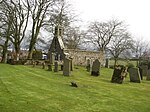Newbigging railway station
1867 establishments in Scotland1945 disestablishments in ScotlandDisused railway stations in South LanarkshireFormer Caledonian Railway stationsPages with no open date in Infobox station ... and 6 more
Railway stations in Great Britain closed in 1932Railway stations in Great Britain closed in 1945Railway stations in Great Britain opened in 1867Railway stations in Great Britain opened in 1933Scotland railway station stubsUse British English from January 2020

Newbigging railway station served the hamlet of Newbigging, South Lanarkshire, Scotland from 1867 to 1945 on the Dolphinton branch.
Excerpt from the Wikipedia article Newbigging railway station (License: CC BY-SA 3.0, Authors, Images).Newbigging railway station
A721,
Geographical coordinates (GPS) Address External links Nearby Places Show on map
Geographical coordinates (GPS)
| Latitude | Longitude |
|---|---|
| N 55.6892 ° | E -3.5595 ° |
Address
Newbigging
A721
ML11 8NH
Scotland, United Kingdom
Open on Google Maps






